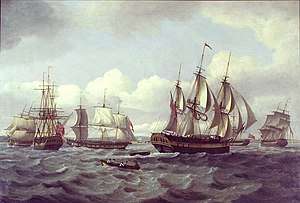Castor (1782 ship)
Castor was a merchantman launched in 1782. She made one voyage for the British East India Company (EIC). Her owners sold her in 1799. She was last listed in 1808.
 | |
| History | |
|---|---|
| Name: | Castor |
| Namesake: | Castor |
| Owner: |
|
| Builder: | Spedding & Co., Whitehaven[1][Note 3] |
| Launched: | 1782 |
| Fate: | Last listed in Lloyd's Register in 1808, and in the Register of Shipping in 1809 |
| General characteristics | |
| Tons burthen: | |
| Complement: | 35[3] |
| Armament: | 16 × 6-pounder guns + 6 × swivel guns[3] |
Lloyd's Register
| Year | Master | Owner | Trade | Notes |
|---|---|---|---|---|
| 1789 | J. Storey | Brocklebank | Whitehaven - West Indies | 400 tons (bm) |
| 1790 | J. Storey J. Stalkheld |
Brocklebank | Whitehaven - Jamaica | |
| 1791 | J. Stalkheld | Brocklebank | London - Madeira | |
| 1792 | J. Stalkeld | Thompson | Hull - New York | |
| 1793 | J. Stalkeld | Thompson | Hull - New York London - Jamaica |
|
| 1794 | J. Stalkeld | Thompson | London - Jamaica | |
| 1795 | J. Stalkeld | Thompson | London - Martinique | 18 × 6-pounder guns |
| 1796 | J. Stalkeld | Thompson | London - Martinique | 18 × 6-pounder guns |
On 10 September 1793, Captain Joseph Salkeld, received a letter of marque for Castor.[3]
Salkeld sailed Castor from Portsmouth on 17 May 1796, bound for Bengal. She reached the Cape on 2 August and remained there until 10 December. She arrived at Calcutta on 8 March 1797. Homeward bound, she was at Diamond Harbour on 7 June, and reached St Helena on 3 September.[4] She left St Helena on 26 September and arrived at The Downs on 30 January 1798.[2] Castor was at Ramsgate on 6 February 1798.[4]
Lloyd's List for 2 February reported that Castor, Salkeld, master, from Bengal, had been run afoul of by Minerva, Blaney, master, in The Downs. Castor was on shore at Ramsgate, and the cargo was expected to be saved.[5] The EIC reported that part of the cargo was saved, and put the value of the cargo that it had lost on Castor at £7878.[6]
By one report, her owners sold Castor to Dutch owners in 1800.[2] Salkeld had by then become master of Minerva and was on his way to Australia, transporting convicts. That same source states that in 1802 Curling and Co., of London, purchased Castor for use as a West Indiaman.[2]
However, by 1799 Curling & Co. already owned Castor. Her master was Mackenzie, and her trade London - Jamaica. She had been lengthened in 1796, and as a result her burthen was now 467 tons. She had also undergone a thorough repair in 1799.[7] Apparently her new owners chose not to arm her, let alone apply for a letter of marque.
Lloyd's Register
| Year | Master | Owner | Trade |
|---|---|---|---|
| 1799 | M'Kenzie | Curling & Co. | London - Jamaica |
| 1800 | M'Kenzie | Curling & Co. | London - Jamaica |
| 1801 | M'Kenzie | Curling & Co. | London - Jamaica |
| 1802 | M'Kenzie A. Sibald |
Curling & Co. | London - Jamaica |
| 1803 | A. Sibald | Curling & Co. | London - Amsterdam |
| 1804 | A. Sibald | Curling & Co. | London - Amsterdam |
| 1805 | A. Sibald | Curling & Co. | London - Amsterdam |
| 1806 | A. Sibald | Curling & Co. | London - Amsterdam |
| 1807 | A. Sibald | Curling & Co. | London - Amsterdam |
| 1808 | A. Sibald | Curling & Co. | London - Amsterdam |
| 1809 | No longer listed | ||
Register of Shipping
| Year | Master | Owner | Trade |
|---|---|---|---|
| 1806 | A. Sibald | Curling & Co. | London - Jamaica |
| 1809 | A. Sibald | Curling & Co. | London - Jamaica |
| 1810 | No longer listed | ||
Notes, citations, and references
Notes
- The ship in the foreground to the right of the painting above bears the name Castor on her stern. It is likely that this is the Castor that Spedding and Co., of Whitehaven, built in 1782.[1]
- One source gives the owner as Captain Salkeld,[2] but the earliest listings in Lloyd's Register give the owner as Brocklebank.
- One source gives the builder as Brocklebank,[2] however Daniel Brocklebank did not start building ships at Whitehaven until 1785.
Citations
- National Museum (Greenwich); BHC3251
- Hackman (2001), p. 227.
- Letter of Marque, 1793-1815; p.38 Archived 9 July 2015 at the Wayback Machine
- British Library: Castor.
- Lloyd's List, n°2982.
- Select... (1830), Vol. 2, p.979.]
- Lloyd's Register (1799).
References
- Hackman, Rowan (2001). Ships of the East India Company. Gravesend, Kent: World Ship Society. ISBN 0-905617-96-7.CS1 maint: ref=harv (link)
- Reports from the Select Committee of the House of Commons appointed to enquire into the present state of the affairs of the East India Company, together with the minutes of evidence, an appendix of documents, and a general index, (1830), Vol. 2, p.977.